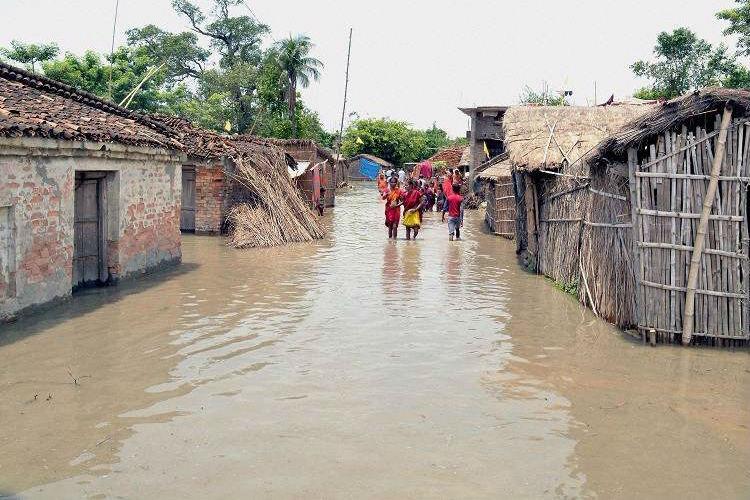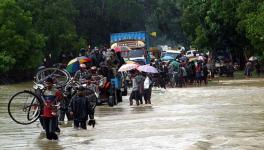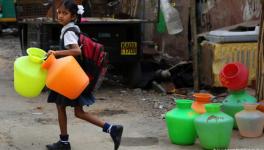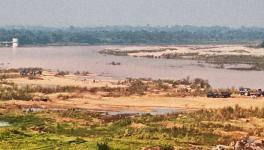India Faced More Extreme Weather Events in 2024, Higher Damages Than Last Year: CSE Report

Inundated villages in Bihar. (File photo/PTI)
Patna/Delhi: With climate change a reality that has been affecting millions around the world, in India also extreme weather events have been steadily on the rise, says the annual ‘State of Extreme Weather’ report by the Centre for Science and Environment (CSE), a New Delhi-based think-tank.
“India has faced more extreme weather events and higher damages in 2024 compared to last year. This year (2024) India faced extreme weather events on 93 per cent of the days in the year’s first nine months -- 255 out of 274 days -- marked by heat and cold waves, cyclones, lightning, heavy rain, floods and landslides. These events claimed 3,238 lives, affected 3.2 million hectare (mha) of crops, destroyed 235,862 houses and buildings, and killed approximately 9,457 livestock,” says the report that was released on Friday in Delhi.
Compared with this, the first nine months of 2023 recorded extreme weather on 235 of 273 days, with 2,923 deaths, 1.84 mha of crops affected, 80,293 houses damaged, and 92,519 animal deaths, it says.
According to report ,the 2024 also set several climate records. January was India’s ninth driest since 1901. In February, the country recorded its second-highest minimum temperature in 123 years. May saw the fourth-highest mean temperature on record, and July, August and September all registered their highest minimum temperatures since 1901.
In the Northwest, January was the second driest, and July recorded the region’s second-highest minimum temperature. The Southern Peninsula saw its hottest February ever, followed by exceptionally hot and dry March and April, but with a 36.5% surplus in July rainfall and the second-highest minimum temperature in August.
CSE director general Sunita Narain said, “These record-breaking statistics reflect climate change’s impact, where events that used to occur once every century are now happening every five years or even less. This frequency is overwhelming the most vulnerable populations, who lack the resources to adapt to this relentless cycle of loss and damage.”
The report highlights event types the past nine months have seen from lightning and storms -- spanning 32 states and resulting in 1,021 deaths -- to relentless monsoon rains, which led to flooding across various regions. In Assam alone, heavy rains, floods and landslides were recorded on 122 days, leaving large parts of the state submerged and communities devastated. Nationwide, 1,376 lives were lost due to floods.
Rajit Sengupta, associate editor of Down To Earth magazine, and one of the writers of this report, said “While heatwaves claimed 210 lives, the data does not reflect the extended health impacts of prolonged high temperatures on the wellbeing of people in North India, including farmers and labourers, who endured intense heat with little means of relief.”
Similarly, the toll of severe cold snaps and frost on crop losses is not captured, highlighting the need for robust compensation systems for weather-induced losses. Without this support, farmers are pushed into debt, exacerbating their marginalisation and poverty, he added.
The report says that Madhya Pradesh experienced extreme weather on 176 days -- the most in the country. Kerala recorded the highest fatalities at 550, followed by Madhya Pradesh (353) and Assam (256). Andhra Pradesh had the most houses damaged (85,806), while Maharashtra, which saw extreme events on 142 days, accounted for over 60% of the affected crop area nation-wide, followed by Madhya Pradesh (25,170 ha).
Regionally, Central India faced the highest frequency of extreme events with 218 days, followed closely by the Northwest at 213 days. In terms of lives lost, the Central region had the most deaths (1,001), followed by the Southern Peninsula (762 deaths), East and Northeast (741 deaths) and Northwest (734 deaths).
Kiran Pandey, programme director of CSE’s environmental resources team and one of the writers of the report, said “27 states and Union Territories saw a rise in extreme weather days in 2024, with Karnataka, Kerala and Uttar Pradesh each experiencing 40 or more additional days of such events.”
Richard Mahapatra, managing editor of Down To Earth, said “This extreme weather report card is essential reading, as it reveals not only the frequency of such events but also the cumulative and far-reaching damage they cause. This underscores the urgent need for systems that accurately capture losses, giving a human face to the impacts of climate change.”
CSE researchers point out that the report highlights a critical shift that is needed in our approach to extreme events -- from disaster response to risk reduction and resilience-building. Flood management, for example, requires more than plans on paper; it calls for the strategic development of drainage and water recharge systems, along with expanded green spaces and forests to act as natural water reservoirs in preparation for future storms.
The report also emphasises the need for climate reparations from high-emission countries responsible for much of the damage. Climate models are clear: extreme weather events are set to become more frequent and severe.
Narain said: “This trend is no longer hypothetical -- it is visible in the escalating crises we face today. This report is not good news, but it is a necessary warning, a call to recognise nature’s backlash and the urgent action required to mitigate it. Without combating climate change at a meaningful scale, today’s challenges will only worsen tomorrow.”
The writer is a freelance journalist based in Patna, Bihar.
Get the latest reports & analysis with people's perspective on Protests, movements & deep analytical videos, discussions of the current affairs in your Telegram app. Subscribe to NewsClick's Telegram channel & get Real-Time updates on stories, as they get published on our website.























